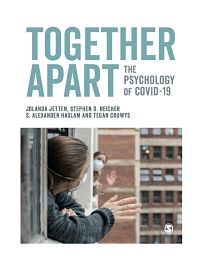Managing Crowds in Crises: Excerpt from ‘Together Apart’
In this post, we build upon the general theme of the last — that is, the importance and the potential of shared social identity to support the COVID-19 response. However, where previously the emphasis was on unity and solidarity between members of the public (e.g., to explain helping), here we address relations between the public and authorities or leaders (e.g., those seeking to increase compliance with physical distance measures). We argue that the consequences of shared identity, which have been shown to be so important in building an effective community response to the pandemic — the mutual trust, influence and support — are equally important when it comes to community–authority relations.
Shared social identity between authorities and the public is the key to an effective pandemic response
At one level, shared identity is necessary if people are to trust government and hence adhere to the restrictions it puts in place (such as lockdown). At another level, people must be willing to listen to officials, to accept the information they provide, and to cooperate with them (Carter et al., 2018). For instance, the success of contact tracing relies on people’s willingness to reveal their contacts if they test positive for COVID-19. However, shared identity between public and authorities is about more than the public obeying instructions from authorities and leaders. Compliance will only ensue when authorities respect and trust the public. Indeed, as we discussed in Chapter 4, it is only when trust is mutual that it becomes possible to formulate, internalise and unite around shared norms concerning health protective behaviours (e.g. Carter et al., 2014; 2015).

Interestingly, these norms are about behaviours that protect the community more than the individual. Hence, if successfully implemented, they create a virtuous cascade of effects. When we see others abide by these norms (e.g., staying home despite the temptation to go out) we grow in trust for others and our sense of shared identity within our communities is strengthened. Moreover, we gain the confidence to challenge those few who violate the norms, secure in the belief that we are acting with the support of others. In this way, communities self-regulate rather than needing the police to intervene and enforce regulations (Drury et al., 2015).
This means that shared identity between authorities and the public has consequences that mirror, and are every bit as important and consequential for the response to COVID-19, as shared identity amongst the public itself. However, when we turn from the consequences to the antecedents of shared identity we begin to see key difference between community–community and community–authority relations. While we showed in Chapter 14 that shared identification between members of the public can arise spontaneously due to a sense of shared fate, the relationship between emergency responders and members of the public is more complex. The authorities and the community are self-evidently not in the same boat in a disaster. Those in a fire engine and those in a fire have very different experiences, as do those deciding on lockdown and those being locked down in this pandemic. As a consequence, the relationship between authorities and the public can never be taken for granted. It must always be worked on and actively nurtured. A central element in that work has to do with what is referred to as procedural justice (Tyler, 2006).
If authorities treat us with fairness, if their encounters with us display trust and respect, and if they listen to us and explain to us how lockdown restrictions are in our interests, then they convey to us that — rather than being an alien force imposed upon us — we are jointly bound together in partnership. In other words, procedural justice promotes shared identity, and therefore all the positive effects described above (Carter et al., 2015). Moreover, as our description suggests, one cannot create a sense of procedural justice and hence of partnership without effective communication (e.g., Carter et al., 2018). Accordingly, in what follows, we suggest five general principles for interacting with the public during major incidents and disasters in order to create shared identity and ensure trust and adherence. These principles can also be used to evaluate the performance of authorities in crises — such as presented by the COVID-19 pandemic.
Research supports five key principles for interacting with the public in a crisis
1. Understand that the way in which responders perceive and manage an incident will affect the way in which members of the public behave — and plan accordingly
Guidance and training for responders and authorities often describes public behaviour during mass emergencies in terms of the ‘panic’ perspective described in Chapter 13 (Carter & Amlôt, 2016). This can lead responders to view the public with hostility, which alienates them, undermines compliance, and produces the very behaviours one is seeking to avoid (Carter et al., 2014; 2018). However, as we noted, behaviour in emergencies is often orderly, cooperative and constructive. This leads to a very different approach which seeks to support and ‘scaffold’ activity rather than to control the public. It is essential that authorities understand this and plan accordingly, consulting with behavioural science and communication experts throughout the incident.
Accordingly, the key question to be asked of the COVID-19 response is whether, when infection hit, the authorities treated the population as a problem, prone to panic and needing to be controlled? Alternatively, did they treat members of the public as partners, acknowledging, supporting, and harnessing the multiple forms of mutual aid which developed in local communities? In short, did the authorities trust the people?
2. Communicate openly and honestly about the nature of an incident, explaining why certain actions are (or are not) being taken
It is vital that authorities communicate openly and honestly with members of the public about what actions they are taking to manage an incident, and why they are taking those actions (Carter et al., 2018). Openness is another key dimension of procedural justice and of building shared identity between responders and the public that encourages adherence (Carter et al., 2015b). Conversely, being seen to withhold information (which can result from a fear that people will panic if told about the dangers they face) can destroy any sense of togetherness and create suspicion between responders and the public.
Were the authorities open with the public? Did they explain the measures they took to control the spread of COVID-19 in the community and make available the scientific advice that lay behind them? If we look at the U.K., the Government has taken the unprecedented steps of naming their advisory committees and allowing access to some of the papers which describe scientific advice they have received (U.K. Government, 2020). This has won them support, but for some people it has not gone far enough (The Guardian, 2020).
3. Communicate in a timely way
The way in which the first minutes or hours of an incident are managed will be crucial for shaping the subsequent nature of the relationship between authorities and members of the public. Authorities should therefore begin communicating immediately and should not wait until all information is known before initiating communication. Where information is not yet available, this should be explained, and updates should be provided as soon as further information becomes available. Regular updates should be provided, even if no new information is known. In all these ways, trust is created and maintained. As we saw from Chapter 13, timely information about dangers — and hence timely reaction — is critical to avoiding fatalities.
Did the authorities communicate and respond to the dangers of COVID-19 early enough? In a number of countries, the issue of whether governments reacted too slowly has been a subject of heated debate. For example, despite officials’ fears that conditions would be conducive to COVID-19’s spread, thousands of Valencia soccer supporters were allowed to travel to Milan in February 2020 to watch their team play in the Champions League. It is highly likely that, after having been in the stadium with 40,000 fans from the Italian city Bergamo (a city at the epicentre of Italy’s COVID-19 outbreak), the virus travelled home to Spain with the Valencia fans. This at least partly explains the high infection rate in Valencia in subsequent weeks (Hawley, 2020).
4. Explain how taking recommended protective actions will promote public health
Advice in an emergency must always be concise and precise so that people know exactly what behaviours are required of them (Michie et al., 2011). But it is not enough to tell people what to do (indeed that can provoke resistance). It is also essential to take people into one’s trust and explain to them why these behaviours are necessary and in their own interests — or, to be more exact, why they are in the interests of their community (see Chapter 14). Accordingly, to bring people on board in a pandemic it is important to provide health-focussed information which explains how desired actions will reduce risks to health so that their loved ones and other members of their community are protected. Conversely, it is necessary to explain how proscribed actions will increase risks to loved ones and community members (Carter et al., 2015; 2018).
In the COVID-19 context, was messaging on protective measures sufficiently clear, and did it explain the basis for these measures? In Britain, many have argued that the earlier advice ‘Stay Home, Protect the NHS, Save Lives’ was clear about what was required and clear about the reasons why: to ‘flatten the curve’ of infection and ensure that the health service was not overwhelmed. Indeed, in a poll of 6,500 people, 91% reported that they felt the slogan made it clear what they had to do (YouGov, 2020). By contrast, an updated slogan, ‘Stay Alert, Control the Virus, Save Lives’, unveiled as lockdown measures began to be lifted, saw only 30% of respondents in the same survey reporting that they were clear about what they were meant to do.
5. Ensure that members of the public are able to undertake recommended actions
Motivation may be important, but it is not sufficient to get people to act on advice. People must also have the opportunity to do what is asked of them (Michie et al., 2011). Telling people to physically distance at work when they are employed in sites where distancing is impossible, or to avoid crowding in public transport when they have no other means of travel, is likely only to create resentment. This means that authorities must identify potential barriers to adherence and empower people to overcome them — through enhanced communication, increased physical support, financial measures and so on (Bonell et al., 2020; see also Chapter 17).
How such questions are dealt with in different countries is central to whether the authorities are seen as guardians or as oppressors in the fight against COVID-19. Indeed, it is central to whether societies work together to contain the virus or turn on each other. This is an issue we unpack further in the section’s next and final chapter.






























































































